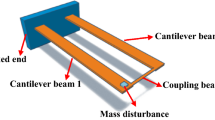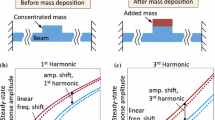Abstract
Mode-localized sensor with amplitude ratio as output metric has shown excellent potential in the field of micromass detection. In this paper, an asymmetric mode-localized mass sensor with a pair of electrostatically coupled resonators of different thicknesses is proposed. Partially distributed electrodes are introduced to ensure the asymmetric mode coupling of second- and third-order modes while actuating the thinner resonator by the distributed electrode. The analytical dynamic model is established by Euler–Bernoulli theory and solved by harmonic balance method (HBM) combined with asymptotic numerical method (ANM). Detailed investigations on the linear and nonlinear behavior, critical amplitude as well as the sensitivity of the sensor are performed. The sensitivity of the proposed sensor can be enhanced by about 20 times compared to first-order mode-localized mass sensors. By exploiting the nonlinearities while driving the device beyond the critical amplitude for the in-phase mode, the sensor performs a great improvement in sensitivity up to 1.78 times compared to linear case. The influence of the coupling voltage on the sensor performance is studied, which gives a good reference to avoid mode aliasing. Moreover, the effect of the length of driving electrode on sensitivity is investigated.














Similar content being viewed by others
References
Fritz, J., et al.: Translating biomolecular recognition into nanomechanics. Science 288(5464), 316–318 (2000)
Burg, T.P., Manalis, S.R.: Suspended microchannel resonators for biomolecular detection. Appl. Phys. Lett. 83(13), 2698–2700 (2003)
Arntz, Y., et al.: Label-free protein assay based on a nanomechanical cantilever array. Nanotechnology 14(1), 86–90 (2002)
Hansen, K.M., et al.: Cantilever-based optical deflection assay for discrimination of DNA single-nucleotide mismatches. Anal. Chem. 73(7), 1567–1571 (2001)
Zhang, H., et al.: Sequence specific label-free dna sensing using film-bulk-acoustic-resonators. IEEE Sens. J. 7(12), 1587–1588 (2007)
Chaste, J., et al.: A nanomechanical mass sensor with yoctogram resolution. Nat Nanotechnol 7(5), 301–304 (2012)
Ekinci, K.L., Yang, Y.T., Roukes, M.L.: Ultimate limits to inertial mass sensing based upon nanoelectromechanical systems. J. Appl. Phys. 95(5), 2682–2689 (2004)
Zhao, J., et al.: A new sensitivity improving approach for mass sensors through integrated optimization of both cantilever surface profile and cross-section. Sens. Actuators, B Chem. 206, 343–350 (2015)
Gao, R., et al.: Method to further improve sensitivity for high-order vibration mode mass sensors with stepped cantilevers. IEEE Sens. J. 17(14), 4405–4411 (2017)
Xie, H., et al.: Enhanced sensitivity of mass detection using the first torsional mode of microcantilevers. Meas. Sci. Technol. 19(5), 39–44 (2008)
Kacem, N., et al.: Dynamic range enhancement of nonlinear nanomechanical resonant cantilevers for highly sensitive NEMS gas/mass sensor applications. J. Micromech. Microeng. 20(4), 045023 (2010)
Younis, M.I., Nayfeh, A.H.: A study of the nonlinear response of a resonant microbeam to an electric actuation. Nonlinear Dyn. 31(1), 91–117 (2003)
Younis, M.I., Alsaleem, F.: Exploration of new concepts for mass detection in electrostatically-actuated structures based on nonlinear phenomena. J. Comput. Nonlinear Dyn. 4(2), 21010 (2009)
Chen, Z., et al.: Performances and improvement of coupled dual-microcantilevers in sensitivity. Sens. Actuators, A 288, 117–124 (2019)
Walter, V., et al.: Electrostatic actuation to counterbalance the manufacturing defects in a MEMS mass detection sensor using mode localization. Proced. Eng. 168, 1488–1491 (2016)
Rabenimanana, T., et al.: Mass sensor using mode localization in two weakly coupled MEMS cantilevers with different lengths: design and experimental model validation. Sens. Actuators, A 295, 643–652 (2019)
Thiruvenkatanathan, P., et al.: Common mode rejection in electrically coupled MEMS resonators utilizing mode localization for sensor applications. In 2009 IEEE International Frequency Control Symposium Joint with the 22nd European Frequency and Time forum. IEEE, pp. 358–363 (2009)
Spletzer, M., et al.: Ultrasensitive mass sensing using mode localization in coupled microcantilevers. Appl. Phys. Lett. 88(25), 254102 (2006)
Spletzer, M., et al.: Highly sensitive mass detection and identification using vibration localization in coupled microcantilever arrays. Appl. Phys. Lett. 92(11), 114102 (2008)
Thiruvenkatanathan, P., et al.: ultrasensitive mode-localized micromechanical electrometer. In: 2010 IEEE International Frequency Control Symposium, pp. 91–96. IEEE, New York (2010)
Ouakad, H.M., Ilyas, S., Younis, M.I.: Investigating mode localization at lower- and higher-order modes in mechanically coupled MEMS resonators. J. Comput. Nonlinear Dynam. 15(3), 031001 (2020)
Thiruvenkatanathan, P., et al.: Ultrasensitive mode-localized mass sensor with electrically tunable parametric sensitivity. Appl. Phys. Lett. 96(8), 081913 (2010)
Ilyas, S., Younis, M.I.: Theoretical and experimental investigation of mode localization in electrostatically and mechanically coupled microbeam resonators. Int. J. Non-Linear Mech. 125, 103516 (2020)
Pandit, M., et al.: Utilizing energy localization in weakly coupled nonlinear resonators for sensing applications. J. Microelectromech. Syst. 28(2), 182–188 (2019)
Lyu, M., et al.: Exploiting nonlinearity to enhance the sensitivity of mode-localized mass sensor based on electrostatically coupled MEMS resonators. Int. J. Non-Linear Mech. 121, 103455 (2020)
Zhao, C., et al.: A mode-localized MEMS electrical potential sensor based on three electrically coupled resonators. J. Sens. Sens. Syst. 6(1), 1–8 (2017)
Kasai, Y., et al.: Ultra-sensitive minute mass sensing using a microcantilever virtually coupled with a virtual cantilever. Sensors (Basel, Switzerland) 20(7), 1823 (2020)
Li, L., et al.: Bifurcation behavior for mass detection in nonlinear electrostatically coupled resonators. Int. J. Non-Linear Mech. 119, 103366 (2020)
Rabenimanana, T., et al.: Functionalization of electrostatic nonlinearities to overcome mode aliasing limitations in the sensitivity of mass microsensors based on energy localization. Appl. Phys. Lett. 117(3), 033502 (2020)
Younis, M.I., Abdel-Rahman, E.M., Nayfeh, A.: A reduced-order model for electrically actuated microbeam-based MEMS. J. Microelectromech. Syst. 12(5), 672–680 (2003)
Baguet, S., et al.: Nonlinear dynamics of micromechanical resonator arrays for mass sensing. Nonlinear Dyn. 95(2), 1203–1220 (2018)
Younis, M., Abdel-Rahman, E., Nayfeh A.: Static and dynamic behavior of an electrically excited resonant microbeam. In: 43rd AIAA/ASME/ASCE/AHS/ASC Structures, Structural Dynamics, and Materials Conference (2002)
Younis, M., Abdel-Rahman, E., Nayfeh, A.: Dynamic simulations of a novel RF MEMS switch. NSTI-Nanotech, pp. 287–290 (2004)
Bruno, et al.: A high order purely frequency-based harmonic balance formulation for continuation of periodic solutions. J. Sound Vib. 324(1–2), 243–262 (2009)
Kacem, N., et al.: Nonlinear phenomena in nanomechanical resonators: mechanical behaviors and physical limitations. Mécan. Ind. 11(6), 521–529 (2011)
Nayfeh, A.H.: Mook, D.: Nonlinear Oscillations. Clarendon (1981)
Kacem, N., et al.: Nonlinear dynamics of nanomechanical beam resonators: improving the performance of NEMS-based sensors. Nanotechnology 20(27), 275501 (2009)
Bitar, D., Kacem, N., Bouhaddi, N.: Investigation of modal interactions and their effects on the nonlinear dynamics of a periodic coupled pendulums chain. Int. J. Mech. Sci. 127, 130–141 (2017)
Jaber, N., et al.: Higher order modes excitation of electrostatically actuated clamped–clamped microbeams: experimental and analytical investigation. J. Micromech. Microeng. 26(2), 025008 (2016)
Jaber, N., et al.: Efficient excitation of micro/nano resonators and their higher order modes. Sci Rep 9(1), 319 (2019)
Hammad, B.K., Abdel-Rahman, E.M., Nayfeh, A.H.: Modeling and analysis of electrostatic MEMS filters. Nonlinear Dyn. 60(3), 385–401 (2009)
Zhao, C., et al.: A three degree-of-freedom weakly coupled resonator sensor with enhanced stiffness sensitivity. J. Microelectromech. Syst. 25(1), 38–51 (2016)
Thiruvenkatanathan, P., et al.: Limits to mode-localized sensing using micro- and nanomechanical resonator arrays. J. Appl. Phys. 109(10), 114–845 (2011)
Acknowledgements
We gratefully acknowledge support from the National Natural Science Foundation of China (No. U1930206), Natural Science Foundation Project of Liaoning Province (No. 2019KF0203) and International Scientific and Technological Cooperation Projects (2019KW-048). This project was also performed in cooperation with EUR EIPHI Program, Europe (Contract No. ANR 17-EURE-0002).
Author information
Authors and Affiliations
Corresponding author
Ethics declarations
Conflicts of interest
The authors declare that they have no conflict of interest.
Additional information
Publisher's Note
Springer Nature remains neutral with regard to jurisdictional claims in published maps and institutional affiliations.
Appendices
Appendix A: Coefficients and forcing terms of the method of multiple scales
The parameters in Eq. (22) are defined as:
Appendix B: Analytical solution using the method of multiple scales
The timescales Tn are introduced depending on the parameter ε and defined by:
The partial differential of time t becomes:
where σ1 is the detuning parameter in Eq. (23) and
The solution of Eq. (22) is assumed by a second-order timescales form as follows:
By substituting Eqs. (32) and (33) into Eq. (22), the equations of each order of ε can be obtained:
Order ε0:
Order ε1:
Order ε2:
The solutions of Eqs. (34) and (35) are given by:
where X1 and X2 are complex functions and \(\overline{{X_{1} }}\) and \(\overline{{X_{2} }}\) are the complex conjugates. Then, substituting q10 and q20 into Eqs. (36) and (37) we obtain:
Eliminating the secular terms in Eqs. (42) and (43) results in:
And the solutions of Eqs. (38) and (39) are:
By substituting the solutions of q11 and q21 into Eqs. (38) and (39), the secular terms can be obtained as:
Let X1 and X2 be as follows:
Substituting Eq. (49) into Eqs. (47) and (48) and multiplying Eq. (47) and Eq. (48) by \({\text{e}}^{{ - {\text{i}}\gamma_{1} }}\) and \({\text{e}}^{{ - {\text{i}}\gamma_{2} }}\), respectively, then separating the real part and the imaginary part, the following relationships can be obtained:
where ϕ1 and ϕ2 are:
In the steady state, we have the conditions \(a^{\prime}_{1} = a^{\prime}_{2} = \phi^{\prime}_{1} = \phi^{\prime}_{2} = 0\); then, we get
From \(\sin \left( {\phi_{1} } \right)^{2} + \cos \left( {\phi_{1} } \right)^{2} = 1\) and \(\sin \left( {\phi_{2} } \right)^{2} + \cos \left( {\phi_{2} } \right)^{2} = 1\), Eqs. (24) and (25) can be obtained.
Rights and permissions
About this article
Cite this article
Zhao, J., Song, J., Lyu, M. et al. An asymmetric mode-localized mass sensor based on the electrostatic coupling of different structural modes with distributed electrodes. Nonlinear Dyn 108, 61–79 (2022). https://doi.org/10.1007/s11071-021-07189-2
Received:
Accepted:
Published:
Issue Date:
DOI: https://doi.org/10.1007/s11071-021-07189-2




